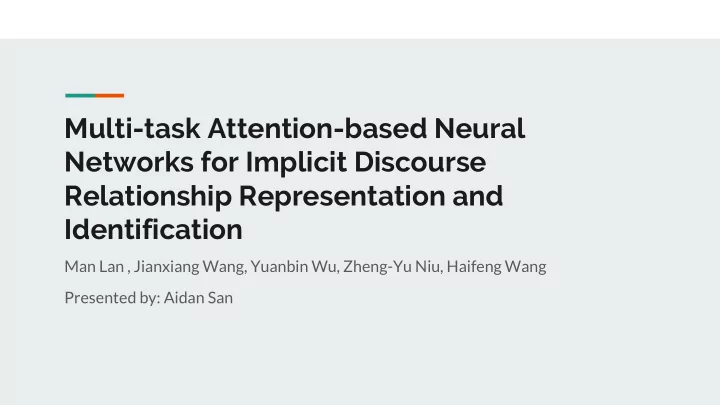

Multi-task Attention-based Neural Networks for Implicit Discourse Relationship Representation and Identification Man Lan , Jianxiang Wang, Yuanbin Wu, Zheng-Yu Niu, Haifeng Wang Presented by: Aidan San
Implicit Discourse Relation “ to recognize how two adjacent text spans without explicit ● discourse marker (i.e., connective, e.g., because or but ) between them are logically connected to one another (e.g., cause or contrast)”
Sense Tags
Implicit Discourse Relation - Motivations Discourse Analysis ● Language Generation ● QA ● Machine Translation ● Sentiment Analysis ●
Summary Attention-based neural network conducts discourse ● relationship representation learning Multi-task learning framework leverage knowledge from ● auxiliary task
Recap - Attention Use a vector to scale certain parts of the input so you can ● “focus” more on that part of the input
Recap - Multi-Task Learning Simultaneously train your model on another task to augment ● yourmodel with additional information PS: Nothing crazy in this paper like training with images ●
Motivation - Attention Contrast information can come from different parts of ● sentence Tenses - Previous vs Now ○ Entities - Their vs Our ○ Whole arguments ○ Attention selections most important part of arguments ●
Motivation - Multi-Task Learning Lack of labeled data ● Information from unlabeled data may be helpful ●
LSTM Neural Network
Bi-LSTM Concatenate Sum-Up Hidden States Concatenate
LSTM Neural Network
Attention Neural Network
What is the other task? Not really a different task ● Using the explicit data for the same task ●
Multi-task Attention-based Neural Network
Knowledge Sharing Methods 1. Equal Share 2. Weighted Share 3. Gated Interaction
Gated Interaction Cont. Acts as a gate to control how ● much information goes to the end result
Datasets - PDTB 2.0 Largest Annotated Corpus of discourse relations ● 2, 312 Wall Street Journal (WSJ) articles ● Comparison (denoted as Comp.), Contingency (Cont.), ● Expansion (Exp.) and Temporal (Temp.)
Datasets - CoNLL-2016 Test - From PDTB ● Blind - From English Wikinews ● Merges labels to remove sparsity ●
Datasets - BLLIP The North American News Text ● Unlabeled data ● Remove Explicit discourse connectives -> Synthetic Implicit ● Relations 100,000 relationships from random sampling ●
Parameters Word2Vec Dimension: 50 ● PDTB ● Hidden State Dimension: 50 ○ Multi-task framework hidden layer size: 80 ○ CoNLL-2016 ● Hidden State Dimension: 100 ○ Multi-task framework hidden layer size: 80 ○
Parameters (cont.) Dropout: .5 (To penultimate layer) ● Cross-Entropy ● AdaGrad ● Learning rate: .001 ○ Minibatch size: 64 ●
Results
Effect of Weight Parameter Low value of W reduces weight of auxiliary task and makes model pay more attention to main task
Conclusion Multi-task attention-based neural network ● Implicit discourse relationship ● Discourse arguments and interactions between annotated ● and unannotated data Outperforms state-of-the-art ●
Recommend
More recommend